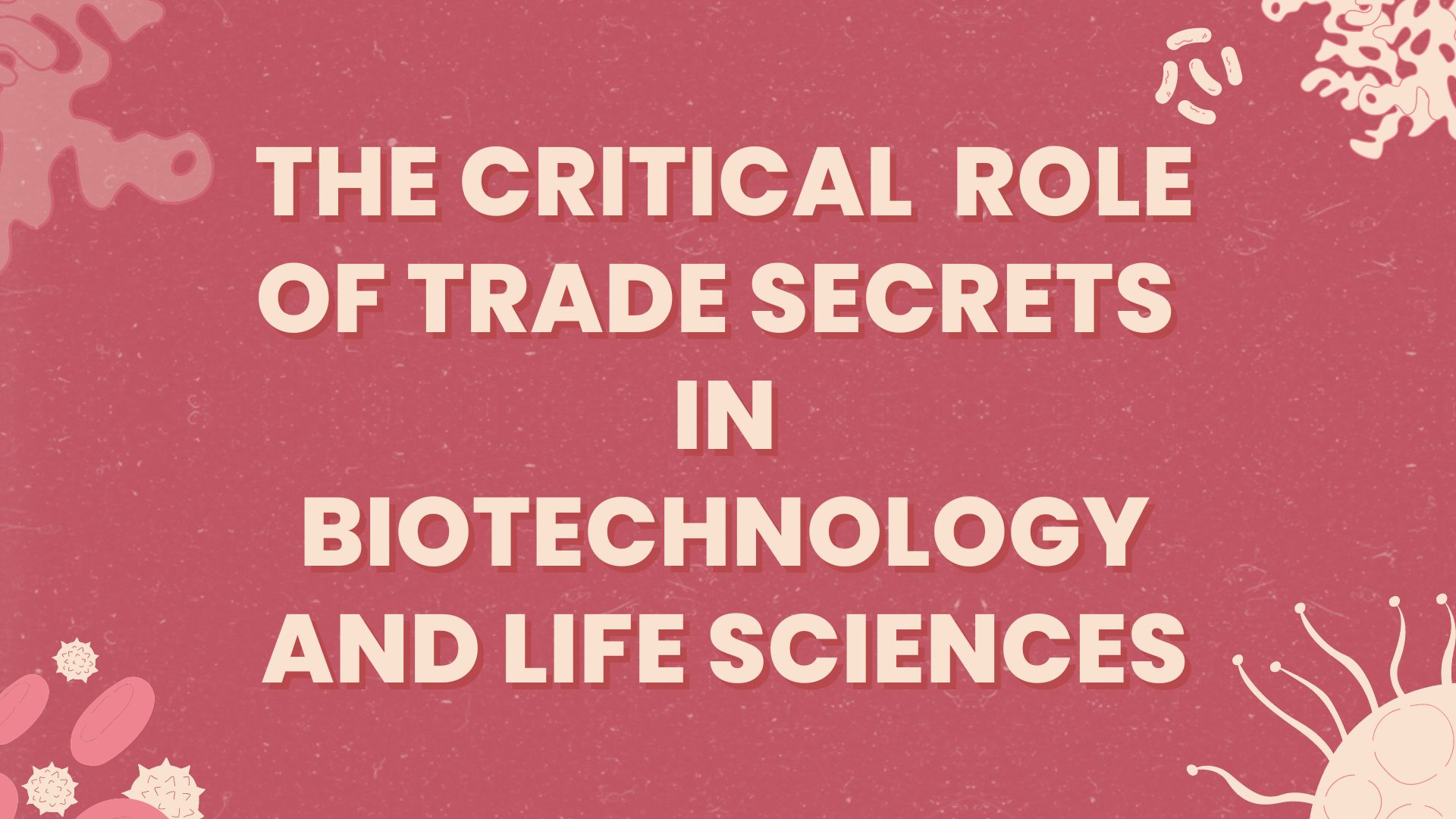In an age of innovation and technology and stricter patent regulations, trade secrets have emerged as a breath of fresh air for companies facing difficulties in obtaining patent protection. Obtaining a patent can be challenging due to the complex procedures, higher thresholds, and various risks involved, which are particularly daunting for smaller companies. Trade secrets offer a simpler and more accessible option, giving it an edge over patents. Our article on Patent vs. Trade Secrets: Making the Right Choice discusses this very debate.
In the fields of biotechnology and life sciences, secrecy is crucial to protect the manufacturing process or invention from falling into the wrong hands. However, the ultimate goal also is to ensure that the benefits of science and technology reach the doorstep of humanity. Opting for Patent protection often requires disclosing key aspects of the invention, which can be used by competitors. Therefore, in a situation where both protection and disclosure become important, inventors and companies must find a way to safeguard their inventions and crucial information. This article delves into this complex aspect of the issue.
Introduction of Trade Secrets in Biotechnology
The core principle of protecting Trade Secrets involves three main aspects: Firstly, it should be a Secret, i.e. the information should be confidential. Secondly, there must be some value to that information such that it is worth protecting. Lastly, to claim damages against the infringement that information should have been taken or breached by improper means such as espionage, theft, bribery, misappropriation, etc. However, it does not include reverse engineering, independent derivation or any other lawful means.
So, why are Trade Secrets important in the fields of biotechnology and life sciences? The answer lies in their versatility. Almost any valuable information can qualify as a Trade Secret as long as it has potential economic value and reasonable efforts have been made to keep it confidential. For example, genetic material, such as a unique DNA sequence, can be protected as a Trade Secret. This was demonstrated in the case of Del Monte Fresh Produce Co. v. Dole Food Co., where a pineapple variety was deemed a trade secret due to its valuable genetic information. Similarly, monoclonal antibodies and hybridoma cell lines, each with a unique DNA sequence, have also been recognised as protectable trade secrets. These examples highlight the diverse range of information that can be safeguarded under the umbrella of trade secrets in biotechnology and life sciences.
Now, since Biotechnology and Life Sciences deal with such crucial data and procedures for, e.g. manufacturing processes, test procedures, formulations, and development research, including preclinical data and Pharmaceutical and drug companies also deal with both large-molecule drugs and small-molecule drugs, such as vaccines, monoclonal antibodies, insulin, along with clinical trial protocols and safety and efficacy data, securing it becomes essential. This is because such data plays a significant role for any Biotech company in a way that even if it is not eligible for Patent protection, it has the potential to either make or break the game in the industry. Therefore, secrecy becomes an important tool to prevent competitors from getting their hands on such data. Thus, such companies or inventors rely on Trade Secrets to protect this data as it proves to be much more effective and reliant than getting it Patented. The lower shelf life of Patents, i.e. 20 years, also contributes to this preference towards Trade Secrets.
Challenges & Risks Accompanying Trade Secrets
- Breach of Secrecy
The most important element of Trade Secrets is secrecy. Although you can protect your important data for an indefinite period of time as a Trade secret, you can also lose it in seconds if the secret somehow gets out. Considering the movement of employees in Biotech companies and the frequent rotation, keeping Trade secrets confidential becomes a challenge. Especially in an era of Digitalization, Trade secrets have become more susceptible to cybersecurity breaches. Thus, strict measures need to be taken to prevent employees from disclosing the trade secret or outsiders from getting their hands on it because the cost of the Trade Secret becoming widely available is much higher than the Cost of ensuring Optimum security.
- Reverse Engineering
Reverse Engineering, also known as Backward engineering refers to analysing and deconstructing various parts of products to understand how it works. In the context of trade secrets, it could also mean analysing an existing product to find out the secret behind its working. In case other entities and competitors independently discover the trade secret through reverse engineering, the owner of the Trade secret will not have any legal recourse against them. The owner can only sue for damages and seek an injunction if the information was obtained illegally or wrongfully. However, by then, it may be too late, as the secret could already be exposed and available for others to use. Thus, for inventions that are easy targets of reverse engineering, opting for Patent protection is a better option.
- Validity & Enforcement
Unlike Patents, where proper rules and regulations have been laid out for the protection of Patentable subject matters and provisions against infringement of the same, trade secrets do not offer such comprehensive legal backing. Many jurisdictions have their own Patent Laws, For, e.g. India regulates Patents under the Patents Act of 1970. However, they lag behind in enforcing laws relating to Trade Secrets. Even in India, there is no separate statute or law for regulating Trade Secrets. Another Problem with enforcing a Trade Secret would be establishing the fact that the secret was obtained by a third party through wrongful means, as more so than often, finding the source of the breach, especially online thefts and fraud, is very hard. Thus, obtaining evidence, especially from foreign entities, becomes a challenge.
- Commercial Disadvantage
Another important reason that people prefer patents is that, in a way, they also serve the purpose of advertising and promotions. Applying for the Patent would mean that the company or the inventor can also raise funds and collaborate with sponsors. Especially for small companies that are yet to establish a name for themselves in the industry or are at a very nascent stage, opting for patent protection would give some value to that company’s name through its patented product. Therefore, in such a situation where keeping a trade secret would, in turn, prove to be a hurdle in getting commercial aid, Patents would be a better option.
Avoiding the Risks
For enforcing a claim of damages or injunction against the breach of Trade Secret, one of the key requirements is also to prove that reasonable efforts were taken by the owner to keep it a secret. Thus, in a way, a huge responsibility lies in the hands of the owner to protect their Trade Secret. This can be done by educating employees on the difference between normal data and data valuable as Trade Secret, limiting access to such data and requiring them to fill non-disclosure agreements. NDAs are also important for preventing the loss of trade secrets by departing staff. Such contracts and agreements should also specifically mention the requirements and obligations related to maintaining the confidentiality of Trade secrets. Thus, properly training employees in this regard proves useful in the long run.
Establishing physical and electronic security is another measure that should be taken seriously by the owners of the Trade Secrets. A strong IT security system is a must to avoid any kind of cyber security breaches or attacks since, in current times, important data is mostly stored online or in electronic systems. Regular checks and a team dedicated towards IT security would ensure the protection even further. Thus, maximum efforts are needed to prevent Trade Secrets from being stolen.
However, even after taking all the measures, the chances of Trade Secrets getting breached will still exist. In the realm of Life Sciences, the case of Eli Lilly v. Emisphere (408 F.Supp.2d 668) (S.D. Ind. 2006) is often quoted to highlight the idea that “perfect security is not the best security”. In this particular case, Lilly and Emisphere had agreements to work together on developing new chemical compounds. This collaboration meant they had to share confidential information. However, when they couldn’t agree on the terms for the next phase of their project, Lilly decided to start its own secret research program. Emisphere, on the other hand, limited access to its electronic files for some, but not all, Lilly scientists, using minimal security measures. One of the Lilly scientists, who had worked with Emisphere, gave a presentation that used materials marked “Confidential—Property of Emisphere Technologies, Inc.” This information helped Lilly with its secret research. Later, Lilly filed for patents that, when published, revealed to Emisphere what Lilly had been working on. Emisphere then sued Lilly for breach of contract and trade secret theft. To settle the dispute, Lilly had to pay Emisphere about $18 million, but the Trade Secret had already been breached.
Way Forward – Creating a Balance
Another way that companies are now dealing with this problem is that in Patents they often withhold detailed information about their drug manufacturing processes. They might give broad or vague descriptions of critical factors like temperature and concentration or list numerous possible methods and host cells (e.g., types of cells used to produce the drug). This practice makes it hard for other companies to replicate the drug, even though patents are supposed to disclose this information in return for a temporary monopoly. By not providing enough details early on, biopharmaceutical companies can keep their manufacturing methods secret for a long time. They might also patent these methods later to extend their exclusive rights and keep prices high.
Thus, technically, secrecy and disclosure do not go hand–in–hand. However, innovators have found a way to balance both by complementing Trade Secrets with Patents. Therefore, the norm in recent times is to keep important data such as manufacturing details a secret by relying on Trade Secrets during the patent process and thereby forcing other companies to spend many years figuring out how to replicate the drug. Meanwhile, the original company can file new patents on these undisclosed methods later on, extending their exclusive rights and delaying cheaper alternatives from reaching the market.
But even though companies are playing smart, the need for separate laws on Trade Secrets cannot be neglected. Especially in a day and age where the internet is widely used and technology keeps advancing, having clear, structured and better-defined laws on Trade Secrets can help the owners protect their secrets and avoid the risk of third-party intervention.
Written by Aasta Verma, Legal Intern @Intepat




